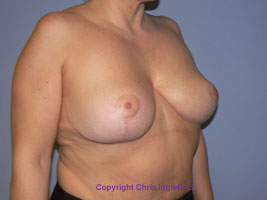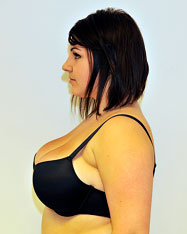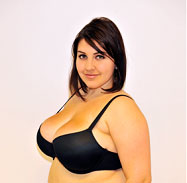
Procedure Time: 2-4 hours
Recovery Time: 1-2 weeks
Results Duration: Permanent removal of breast tissue
Cost: Approx. £3,500 - £5,500
Anaesthesia: General anaesthesia
For a full list of FAQs please Click Here.
Breast reduction or mammaplasty is an operation that removes fat, glandular tissue, and skin from the female breasts to reduce and reshape them. Afterwards, the breasts should have a more youthful shape and the discomfort of living with heavy breasts should disappear. Many women who have large breasts find them very uncomfortable as they go about their daily lives. They often suffer from terrible back pain, pain in their shoulders and neck, and even wearing a bra can cause irritation as the straps dig into their skin. Large breasts may also prevent a woman performing normal daily activities such as exercising, and unusually large breasts can make a woman or a teenage girl feel extremely self-conscious. Breast reduction surgery is nearly always performed under a general anaesthetic. Some people may be up and about in a day or two, but you shouldn't plan on returning to (non-strenuous work) for around one to two weeks after surgery. Private costs for a breast reduction can range from approximately £3,500 - £5,500
Do you have a question? Ask one of our experts NOWMany women who have large breasts find them very uncomfortable as they go about their daily lives. They often suffer from terrible back pain, pain in their shoulders and neck, and even wearing a bra can cause irritation as the straps dig into their skin. Large breasts may also prevent a woman performing normal daily activities such as exercising, and unusually large breasts can make a woman or a teenage girl feel extremely self-conscious.
Breast reduction - technically known as a reduction mammaplasty - is an operation that removes fat, glandular tissue, and skin from the breasts to reduce and reshape them. Afterwards, the breasts should have a more youthful breast shape and the discomfort of living with heavy breasts should disappear.
Statistics from the American Society for Aesthetic Plastic Surgery (ASAPS) report that 86,543 breast reduction procedures were performed in 2019 in the U.S., an increase of 2.3% on 2018 figures. No official figures are available for the UK yet, but we do know that this is an operation which is growing in popularity for both medical and cosmetic reasons.
If you are considering a breast reduction, the following information will give you a basic understanding of the procedure. It cannot answer all your questions, since a lot depends on the individual patient and the surgeon.
Please ask your surgeon about anything you don't understand.
At your first consultation with a surgeon, you should clearly set out what you expect from the surgery and how you would like to look afterwards.
The surgeon will want to know exactly why you want to have your breasts reduced in size and it is important that you discuss this openly and in full detail. The surgeon will then examine your breasts and measure them while you're sitting or standing. He or she will discuss the factors that may affect the operation, such as your age, the size and shape of your breasts, and the condition of your skin. You should also discuss where the nipple and areola (the brownish area around the nipples) will be positioned.
A medical history should be taken, to make sure that there are no reasons why you shouldn’t have the surgery. You would normally be asked to read the information contained in a consent form and sign to say that you have understood the potential benefits and risks associated with breast reduction surgery.
Photographs may also be taken by the practitioner for a “before and after” comparison at a later date.
The surgeon may wish to write to your G.P. giving details of the operation so that if there are any problems associated with surgery in the short or long-term, the G.P. is aware of the procedure and can help with your recovery.
Anaesthesia
Breast reduction surgery is nearly always performed under a general anaesthetic. In some cases, your surgeon may advise the use of a local anaesthetic, combined with a sedative to make you drowsy, so that you remain awake but feel very little discomfort during the operation.
Remember that any general anaesthetic has its own small risks attached to it and your surgeon should discuss them with you before any decisions about the operation are made.
The operation
Your breast lift would usually be performed in a hospital and does not normally require an overnight stay. The procedure would normally take between two and four hours.
There are various techniques used for breast reduction, but the most common involves cutting around the areola, down the breast and then underneath the breast along the natural curve of the crease beneath the breast. The cut is sometimes referred to as being shaped like an anchor.
The surgeon removes excess tissue and skin, and moves the nipple and areola into their new positions. Skin from both sides of the breast is then pulled down and around the areola, making the new shape of the breast. Any excess fat can then be removed with the use of liposuction in the armpit area. A tube is put into the armpit and the fat is simply sucked out through it.
In most cases, the nipples remain attached to their blood vessels and nerves as they are being moved. However, if the breasts are very large or heavy and drooping, the nipples and areolas may have to be completely removed and grafted into a higher position. (This will result in a loss of sensation in the nipples and areola.)
Stitches usually go round the areola, in a line down the breast, and then underneath the breast in the lower crease.
In some cases, techniques can be used that remove the need to cut vertically down the breast. Hence, causing much less scarring.
Occasionally, when only fat needs to be removed, liposuction alone can be used to reduce breast size, leaving very few scars. This is more appropriate in younger patients.
Everyone heals at a different rate. Some patients may be up and about in a day or two, but you shouldn’t plan on returning to (non-strenuous work) for around one to two weeks after surgery.
Your breasts will be tender and swollen after this operation. Just how much swelling and bruising you experience depends on how easily you bruise and how quickly you heal. Swelling can last for many months in some individuals, but this is rare.
Risks or side effects following the procedure can include infection, a reaction to the anaesthetic, bleeding and nerve damage.
Bleeding and infection following a mammaplasty are uncommon, but can cause scars to open up if they occur.
This surgery does leave noticeable, permanent scars. They often remain lumpy and red for several months, then gradually become less obvious. Eventually they can fade to thin white lines. Poor healing and wider scars are more common in smokers. The procedure can also leave you with lopsided nipples, or a permanent loss of feeling in your nipples or breasts.
It is very important that you follow the advice of your surgeon carefully after your operation.
Post-surgery advice may include:
Most people can have a breast reduction as long as they are in good health generally and are realistic about what the operation can do for them.
If you are prone to keloid (red, angry, raised) scars, or have a history of problems with wound healing your surgeon may not recommend this procedure or may caution you that scars could be raised and very visible.
Only fully trained and qualified surgeons should perform a female breast reduction operation.
For more information about practitioner training, qualifications and relevant medical organisations please view the information contained within the Legislation section of the Consulting Room.
If it is decided that your breast reduction is medically necessary, then you can have your surgery on the NHS, or your private healthcare insurance may pay for it.
You will need to see your G.P. for the first referral to a breast surgeon in the National Health Service, or check your policy details if you have a private health plan.
The NHS has set out the following guidelines on how to get cosmetic surgery through the NHS:
"To qualify for surgery on the NHS you must meet specific criteria as set out by your local health authority. The NHS will not pay for surgery for cosmetic reasons alone. Reconstructive and cosmetic surgery to correct, or improve, congenital abnormalities and injuries will usually be carried out free of charge.
NHS reconstructive surgery is performed by plastic surgeons who have had extensive training and belong to the British Association of Plastic Reconstructive and Aesthetic Surgeons. Surgeons who carry out cosmetic surgery through the NHS also belong to the British Association of Aesthetic Plastic Surgeons.
To receive cosmetic surgery from the NHS, you will normally need a referral from your GP. You will have a consultation with a plastic surgeon and an assessment by a psychiatrist, or psychologist. It will then be decided whether there is enough social, psychological, or physical benefit to be gained to justify surgery."
Prices for a private mammaplasty or female breast reduction procedure can be in the £3,500 - £5,500 range.
Breast reduction or mammaplasty can result in one of the quickest and most dramatic changes in your physical shape that cosmetic surgery can offer. It will rid you of the physical discomfort of large breasts, your body will look better proportioned, clothes will fit you better, and you will probably feel less self conscious.
Remember, however, that you may need to be patient as swelling and scarring after this operation can take many months to settle down. Be patient – it will be worth it!
Please note that results of cosmetic surgery vary enormously, depending upon both the patient and the skill of the individual surgeon, so outcomes for procedures will always be more variable than those for less invasive non-surgical treatments.
(All before and after photographs featured are real patients treated by highly experienced surgeons, your results may differ).


Natural breasts before reduction surgery and 3 months after breast reduction surgery.
Photographs courtesy of Consultant Plastic Surgeon, Mr Christopher Inglefield, BSc, MBBS, FRCS (Plast) at London Bridge Plastic Surgery.




Young female, breast reduction operation using a micro-liposuction technique (Before - Left, After - Right). 8 week follow-up on photos.
Photographs courtesy of The Private Clinic.